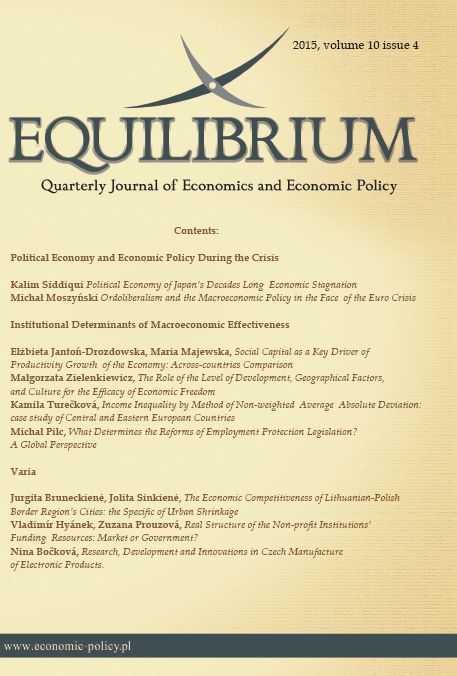What determines the reforms of employment protection legislation? A global perspective
DOI:
https://doi.org/10.12775/EQUIL.2015.038Keywords:
political economics, employment protection legislation, labor law, labor market institutions, labor market policyAbstract
The aim of this research was to identify the determinants of the employment protection legislation reforms in the global perspective. The study was based on the Labor Freedom index published by the Heritage Foundation, which allowed to include 179 countries in the research that were observed in the period 2003?2013. The conducted study has indicated that changes in GDP and the level of employment in industry may induce the introduction of labor reforms. The changes in the labor law also occurred to be correlated with the number of the nearly excluded from the labor market (the long-term unemployed and youth not in education, employment or training) and also with changes in the government expenditure. However, all these factors may lead to substantially various reform programs in particular countries due to the heterogeneous political pressure of the labor market interest groups and different governmental determination in introduction of the reforms.
Downloads
References
Arellano, M. (1987). Computing Robust Standard Errors for Within Group Estimators. Oxford Bulletin of Economics and Statistics, 49.
Arellano, M., & Bover, O. (1995). Another look at the instrumental variable estimation of error-components models. Journal of Econometrics, 68(1). DOI: http://dx.doi.org/10.1016/0304-4076(94)01642-D.
Arpaia, A., & Mourre, G. (2005). Labour Market Institutions and Labour Market Performance: A Survey of the Literature. European Commission Economic Papers, 238.
Bertola, G., & Koeniger, W. (2004). Consumption smoothing and the structure of labor and credit markets. IZA Discussion Paper, 1052.
Blanchard, O. (2006). European unemployment: the evolution of facts and ideas. Economic policy, 21(45). DOI: http://dx.doi.org/10.1111/j.1468-0327.2006 .00153.x.
Blanchard, O., & Wolfers, J. (2000). The role of shocks and institutions in the rise of European unemployment: the aggregate evidence. The Economic Journal, 110(462). DOI: http://dx.doi.org/10.1111/1468-0297.00518.
Blundell, R., & Bond, S. (1998). Initial conditions and moment restrictions in dynamic panel data models. Journal of Econometrics, 87. DOI: http://dx.doi.org /10. 1016/S0304-4076(98)00009-8.
Boeri, T. (2005). Reforming Labour and Product Markets: Some Lessons from Two Decades of Experiments in Europe. IMF Working Paper, 05/97.
Boeri, T., Conde-Ruiz, J. I., & Galasso, V. (2003). Protecting Against Labour Market Risk: Employment Protection or Unemployment Benefits? IZA Discussion Paper, 834.
Boeri, T., & Garibaldi, P. (2006). Two tier reforms of employment protection: A honeymoon effect? Economic Journal, 17. DOI: http://dx.doi.org/10.1111/ j.1468-0297.2007.02060.x.
Boeri, T., & Van Ours, J. (2008). The Economics of Imperfect Labor Markets. Princeton: Princeton University Press.
Cazes, S., & Nesporova, A. (2003). Labour Markets in Transition: Balancing Flexibility and Security in Central and Eastern Europe, Geneva: ILO. DOI: http://dx.doi.org/10.3917/reof.075.0023.
Dolado, J. J., García?Serrano, C., & Jimeno, J. F. (2002). Drawing lessons from the boom of temporary jobs in Spain. The Economic Journal, 112(480). DOI: http://dx.doi.org/10.3917/reof.075.0023.
Drazen, A. (2002). Political economy in macroeconomics. Princeton: Princeton University Press.
Eichhorst, W., & Marx, P. (2011). Reforming German labour market institutions: A dual path to flexibility. Journal of European Social Policy, 21(1). DOI: http://dx.doi.org/10.1177/0958928710385731.
Heritage Foundation (2014). Labor Freedom. Retrieved from http://www.heritage. org/index/labor-freedom (19.11.2014).
Layard, R., Nickell, S., & Jackman, R. (2005). Unemployment. Macroeconomic Performance and the Labour Market, 2nd ed. Oxford: Oxford University Press.
Lehmann, H., & Muravyev, A. (2012). Labor Market Institutions and Labor Market Performance: What Can We Learn from Transition Countries? Economics of Transition, 20(2). DOI: http://dx.doi.org/10.2139/ssrn.1681525.
Nickell, S. (1997). Unemployment and labor market rigidities: Europe versus North America, Journal of Economic Perspectives, 11(3). DOI: http://dx.doi.org/10.1257/jep.11.3.55.
OECD (2014). OECD Indicators of Employment Protection. Retrieved from http://www.oecd.org/employment/emp/oecdindicatorsofemploymentprotection.htm (29.12.2014).
Saint-Paul, G. (1996). Exploring the Political Economy of Labour Market Institutions. Economic Policy, 11(23).
Saint-Paul, G. (2002). The Political Economy of Employment Protection. Journal of Political Economy, 110(3).
Swamy P., Arora S. (1972). The Exact Finite Sample Properties of the Estimators of Coefficients in the Error Components Regression Models. Econometrica, 40. DOI: http://dx.doi.org/10.2307/1909405.
World Bank (2014). World Development Indicators database. Retrieved from http://data.worldbank.org/products/wdi (21.11.2014).






